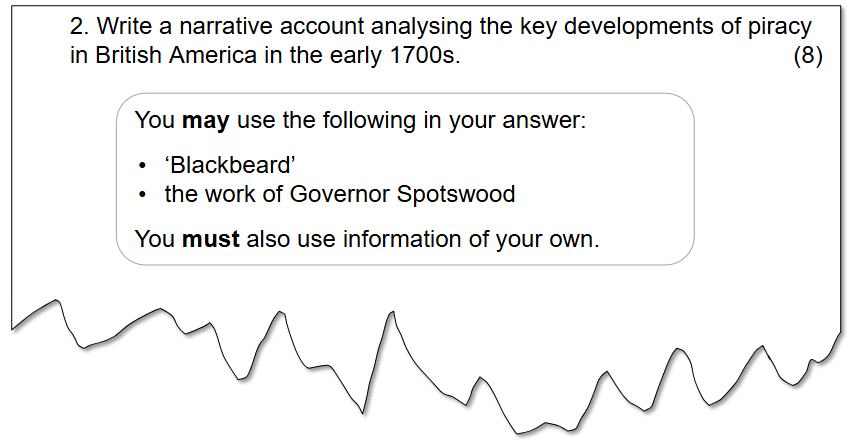The 8 Mark "Write a Narrative Account" Question (Edexcel GCSE History): Revision Note
Exam code: 1HI0
Summary of Question 2
Question 2 requires you to write an analytical narrative
This means explaining a sequence of key events and how they are linked together
You must write about each stage of the narrative in chronological order
Amount of marks | 8 |
|---|---|
The time that you should spend on the question | No more than 15 minutes |
An example of the type of question you may encounter can be seen below:

In previous years, this question has focused on the following topics for British America, 1713–83:
Year of exam | Question topic |
|---|---|
2018 | Relations between the colonists and Native Americans, 1763-64 (opens in a new tab) |
2019 | The New York Conspiracy in 1741 (opens in a new tab) |
2020 | Deterioration of British and American relations, 1770–75 (opens in a new tab) |
2021 | No paper available |
2022 | British and American relations, 1774–75 (opens in a new tab) |
2023 | The American War of Independence, 1775–81 (opens in a new tab) |
2024 | Stono Rebellion (1739) |
The importance of chronology
Chronology is the ability to place events in time order
In the narrative account, you must write about three events in the correct order
If you write the events out of order, you will only get 2 marks
Do not include events outside the time frame of the question
To help, the exam provides you with two stimulus points
The stimulus points are sometimes given with dates
If not, the stimulus points are arranged in time order
If you do not know the stimulus points, you are allowed to use your own knowledge
If you only use the two stimulus points, you can only achieve a maximum of four marks
Sequencing and linkage in GCSE history
Sequencing
Sequencing in history is the order in which events happened
For the example question, "Blackbeard" came before the work of Governor Spotswood
A sequence of events could:
Happen over a short or long period of time
Stretch over multiple events
Have negative and positive impacts
When explaining sequencing, you need to be careful not to write a story
Instead, your answer should explain how one event led to another
Linkage
A linkage in history refers to the connections between events or issues
For the example question, the Piracy Act connects to the work of Governor Spotswood
Linkage allows historians to:
Compare historical events
Explain the causes and consequences of an event
Explain the wider developments of a period
Use connective phrases like:
"As a result … "
"Consequently … "
"This led to … "
"Because of this … "
Planning your answer will make it easier to make linkages

How to answer a "Write a narrative account" question
Your answer should include:
The organisation of three events in chronological order
Specific and relevant knowledge of each event in the narrative account
An explanation of how each event connects to the next
Before you write the answer, ensure that you have the following:
Good knowledge of the three events that you are using in the narrative account
A clear understanding of how each event links together
This will allow you to achieve the analytical narrative that the examiner is looking for
To create successful linkages for British America, you should consider if the event:
Improved or damaged British-American relations
Increased or decreased British power in the Americas
Developed the colonial society, culture or economy
"Write a narrative account" question structure
Your answers could be written using a CHRONOLINK structure
CHRONO — Put the sequence of events in chronological order
LINK — Connect each section of the narrative to the next event that occurred
To achieve full marks, you should aim to write about three events in the narrative account
These events can be organised into one paragraph per event or one continuous paragraph
The question is out of 8 marks
4 marks for knowledge (K)
4 marks for your analysis of the second-order concepts of causes, consequences and/or changes (SOC)
Worked example of a "Write a narrative account" question
Worked Example
Write a narrative account analysing the key developments of piracy in British America in the early 1700s.
(8)
You may use the following in your answer:
You must also use information of your own. |
Answer:
One key development in the early 1700s was the rise of piracy in British America (K). This was caused by war and a lack of control of the seas. As a result, notorious pirates such as Edward Teach, also known as "Blackbeard", were able to thrive. In 1717, he captured a large French ship and renamed it the Queen Anne’s Revenge. This growing threat to trade and colonial safety led to rising concern among colonial governors and merchants (SOC).
As a consequence, the British government acted by passing the Piracy Act in 1717. The Piracy Act allowed colonial courts to try pirates locally and introduced the death penalty for piracy (K). This legislation was significant because it gave colonial authorities new powers to prosecute and punish pirates, showing that the British government now viewed piracy as a serious criminal and economic threat (SOC).
Due to these new powers, some colonial leaders took more aggressive steps. One example was Governor Spotswood of Virginia. In 1718, he launched a military expedition to deal with Blackbeard directly. He sent Lieutenant Robert Maynard to confront Blackbeard near Ocracoke Island. After a violent battle, Blackbeard was killed, and his head was displayed on Maynard’s ship (K). This action had a powerful impact because it showed that the colonies were no longer relying on pardons and were now using force to suppress piracy (SOC). As a result, other governors followed Spotswood’s actions, ending the Golden Age of Piracy.

Unlock more, it's free!
Did this page help you?